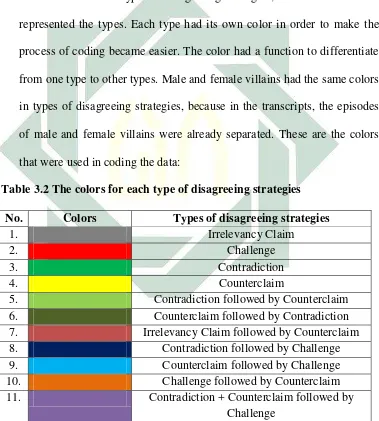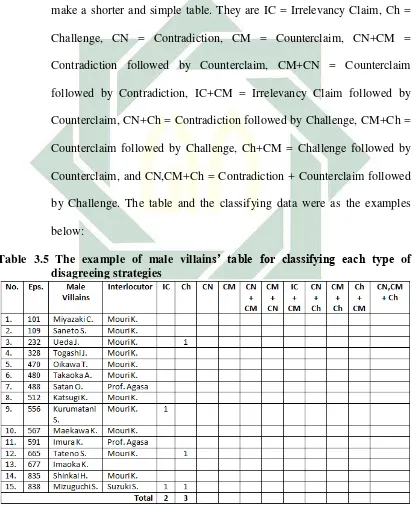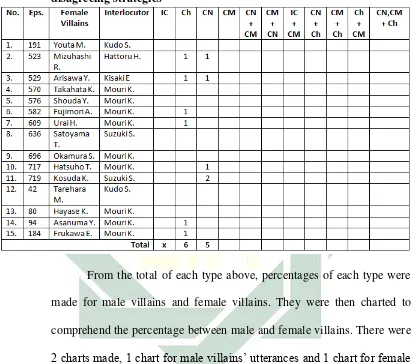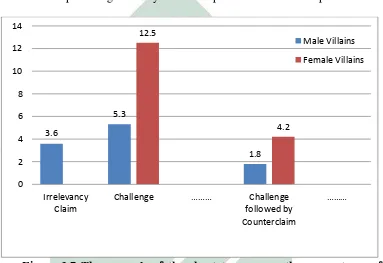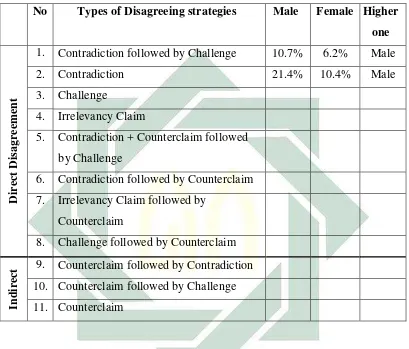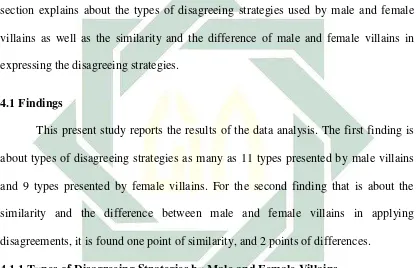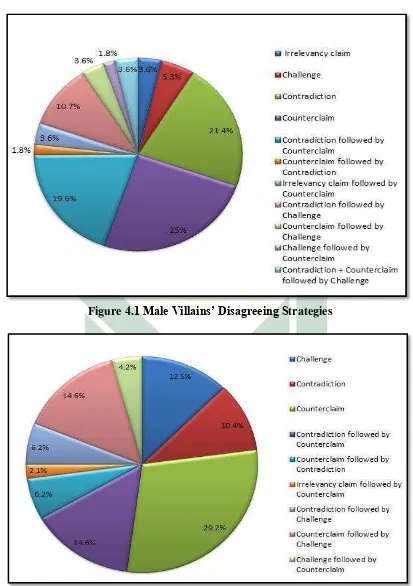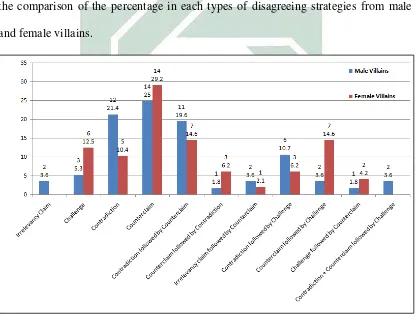VARIOUS VERBAL DISAGREEING STRATEGIES APPLIED BY MALE AND FEMALE VILLAINS IN DETECTIVE CONAN MOVIE SERIES
THESIS
Submitted as Partial Fulfillment as the Requirements for the Sarjana Degree of English Department Faculty of Arts and Humanities UIN Sunan Ampel
Surabaya
By:
Himmatul Maratis Suroiya Reg. Number A03213023
ENGLISH DEPARTMENT
FACULTY OF ARTS AND HUMANITIES
THE STATE ISLAMIC UNIVERSITY OF SUNAN AMPEL SURABAYA
ii
VARIOUS VERBAL DISAGREEING STRATEGIES APPLIED BY MALE AND FEMALE VILLAINS IN DETECTIVE CONAN MOVIE SERIES
THESIS
Submitted as Partial Fulfillment as the Requirements for the Sarjana Degree of English Department Faculty of Arts and Humanities UIN Sunan Ampel
Surabaya
By:
Himmatul Maratis Suroiya Reg. Number A03213023
ENGLISH DEPARTMENT
FACULTY OF ARTS AND HUMANITIES
THE STATE ISLAMIC UNIVERSITY OF SUNAN AMPEL SURABAYA
digilib.uinsby.ac.id digilib.uinsby.ac.id digilib.uinsby.ac.id digilib.uinsby.ac.id digilib.uinsby.ac.id digilib.uinsby.ac.id digilib.uinsby.ac.id
digilib.uinsby.ac.id digilib.uinsby.ac.id digilib.uinsby.ac.id digilib.uinsby.ac.id digilib.uinsby.ac.id digilib.uinsby.ac.id digilib.uinsby.ac.id
digilib.uinsby.ac.id digilib.uinsby.ac.id digilib.uinsby.ac.id digilib.uinsby.ac.id digilib.uinsby.ac.id digilib.uinsby.ac.id digilib.uinsby.ac.id
digilib.uinsby.ac.id digilib.uinsby.ac.id digilib.uinsby.ac.id digilib.uinsby.ac.id digilib.uinsby.ac.id digilib.uinsby.ac.id digilib.uinsby.ac.id
digilib.uinsby.ac.id digilib.uinsby.ac.id digilib.uinsby.ac.id digilib.uinsby.ac.id digilib.uinsby.ac.id digilib.uinsby.ac.id digilib.uinsby.ac.id
digilib.uinsby.ac.id digilib.uinsby.ac.id digilib.uinsby.ac.id digilib.uinsby.ac.id digilib.uinsby.ac.id digilib.uinsby.ac.id digilib.uinsby.ac.id
xiii ABSTRACT
Suroiya, H.M. 2017. Various Verbal Disagreeing Strategies Applied by Male and Female Villains in Detective Conan Movie Series. English Department, Faculty of Arts And Humanities. The State Islamic University of Sunan Ampel Surabaya.
The advisor: Prof. Dr. Hj. Zuliati Rohmah M.pd
Key words: Disagreeing strategies, villains, Detective Conan movie series
Since disagreements have been getting much attention from various researchers in numerous subjects, this thesis investigates them in villains’ utterances. None of previous researchers have analyzed disagreements in villains’ utterances. In addition, the similarities and the differences between male and female villains in applying the disagreeing strategies are also investigated to enrich the previous studies about disagreement in gender field.
The types of disagreeing strategies which help the researcher to anayze the disagreeing strategies in villains are based on Muntigl and Turnbull taxonomy (1998). Besides, some previous studies from Kozcogh (2011), Faharani and Molkizadeh (2013), Bavarsad et al. (2015), Aisyah (2015), and Heidari et al. (2015), inspire the researcher a lot in analyzing the similarity and the difference between male and female villains in applying the disagreements, since their study also analyzed the differences in men and women. Qualitative content analysis and descriptive research designs are chosen to investigate male and female villains’ utterances which consist of disagreeing strategies. The researcher herself becomes the only instrument – human instrument. Reading and selecting the entire scripts of Detective Conan movie series become the steps of data collection. Then, the procedures of data analysis contain identifying, classifying, and elaborating the data. Drawing the conclusion is also the last step required.
digilib.uinsby.ac.id digilib.uinsby.ac.id digilib.uinsby.ac.id digilib.uinsby.ac.id digilib.uinsby.ac.id digilib.uinsby.ac.id digilib.uinsby.ac.id
digilib.uinsby.ac.id digilib.uinsby.ac.id digilib.uinsby.ac.id digilib.uinsby.ac.id digilib.uinsby.ac.id digilib.uinsby.ac.id digilib.uinsby.ac.id
digilib.uinsby.ac.id digilib.uinsby.ac.id digilib.uinsby.ac.id digilib.uinsby.ac.id digilib.uinsby.ac.id digilib.uinsby.ac.id digilib.uinsby.ac.id
digilib.uinsby.ac.id digilib.uinsby.ac.id digilib.uinsby.ac.id digilib.uinsby.ac.id digilib.uinsby.ac.id digilib.uinsby.ac.id digilib.uinsby.ac.id
digilib.uinsby.ac.id digilib.uinsby.ac.id digilib.uinsby.ac.id digilib.uinsby.ac.id digilib.uinsby.ac.id digilib.uinsby.ac.id digilib.uinsby.ac.id
digilib.uinsby.ac.id digilib.uinsby.ac.id digilib.uinsby.ac.id digilib.uinsby.ac.id digilib.uinsby.ac.id digilib.uinsby.ac.id digilib.uinsby.ac.id
xiv INTISARI
Suroiya, H.M. 2017. Various Verbal Disagreeing Strategies Applied by Male and Female Villains in Detective Conan Movie Series. Sastra Inggris, Fakultas Adab dan Humaniora. Universitas Islam Negeri Sunan Ampel Surabaya.
Pembimbing: Prof. Dr. Hj. Zuliati Rohmah, M.pd.
Kata kunci: Strateg-strategi ketidaksetujuan/pertentangan, penjahat, film seri Detective Conan
Karena ketidaksetujuan telah mendapat banyak perhatian dari berbagai peneliti di berbagai bidang, tesis ini menginvestigasinya di dalam ucapan para penjahat. Tidak ada peneliti sebelumnya yang telah menganalisis ketidaksetujuan dalam ucapan para penjahat. Selain itu, persamaan dan perbedaan antara penjahat laki-laki dan perempuan dalam menerapkan strategi ketidaksetujuan juga diselidiki untuk memperkaya studi sebelumnya tentang ketidaksetujuan di bidang gender.
Jenis strategi ketidaksetujuan yang membantu peneliti untuk menganalisa strategi ketidaksetujuan pada penjahat didasarkan pada taksonomi Muntigl dan Turnbull (1998). Selain itu, beberapa penelitian sebelumnya seperti dari Kozcogh (2011), Faharani dan Molkizadeh (2013), Bavarsad dkk. (2015), Aisyah (2015), dan Heidari dkk. (2015), sangat mengilhami peneliti dalam menganalisis kesamaan dan perbedaan antara penjahat pria dan wanita dalam menerapkan strategi ketidaksetujuan, karena studi mereka juga menganalisis perbedaan pria dan wanita. Analisis isi kualitatif dan desain penelitian deskriptif dipilih untuk menyelidiki ucapan para penjahat pria dan wanita dalam ucapan ketidaksetujuan. Peneliti sendiri menjadi satu-satunya instrumen - instrumen manusia. Membaca dan memilih seluruh naskah seri film Detective Conan menjadi langkah pendataan. Kemudian, prosedur analisis data berisi identifikasi, klasifikasi, dan perincian data. Menggambar kesimpulan juga merupakan langkah terakhir yang dibutuhkan.
digilib.uinsby.ac.id digilib.uinsby.ac.id digilib.uinsby.ac.id digilib.uinsby.ac.id digilib.uinsby.ac.id digilib.uinsby.ac.id digilib.uinsby.ac.id
digilib.uinsby.ac.id digilib.uinsby.ac.id digilib.uinsby.ac.id digilib.uinsby.ac.id digilib.uinsby.ac.id digilib.uinsby.ac.id digilib.uinsby.ac.id
digilib.uinsby.ac.id digilib.uinsby.ac.id digilib.uinsby.ac.id digilib.uinsby.ac.id digilib.uinsby.ac.id digilib.uinsby.ac.id digilib.uinsby.ac.id
digilib.uinsby.ac.id digilib.uinsby.ac.id digilib.uinsby.ac.id digilib.uinsby.ac.id digilib.uinsby.ac.id digilib.uinsby.ac.id digilib.uinsby.ac.id
digilib.uinsby.ac.id digilib.uinsby.ac.id digilib.uinsby.ac.id digilib.uinsby.ac.id digilib.uinsby.ac.id digilib.uinsby.ac.id digilib.uinsby.ac.id
digilib.uinsby.ac.id digilib.uinsby.ac.id digilib.uinsby.ac.id digilib.uinsby.ac.id digilib.uinsby.ac.id digilib.uinsby.ac.id digilib.uinsby.ac.id
digilib.uinsby.ac.id digilib.uinsby.ac.id digilib.uinsby.ac.id digilib.uinsby.ac.id digilib.uinsby.ac.id digilib.uinsby.ac.id digilib.uinsby.ac.id
digilib.uinsby.ac.id digilib.uinsby.ac.id digilib.uinsby.ac.id digilib.uinsby.ac.id digilib.uinsby.ac.id digilib.uinsby.ac.id digilib.uinsby.ac.id
digilib.uinsby.ac.id digilib.uinsby.ac.id digilib.uinsby.ac.id digilib.uinsby.ac.id digilib.uinsby.ac.id digilib.uinsby.ac.id digilib.uinsby.ac.id
digilib.uinsby.ac.id digilib.uinsby.ac.id digilib.uinsby.ac.id digilib.uinsby.ac.id digilib.uinsby.ac.id digilib.uinsby.ac.id digilib.uinsby.ac.id
digilib.uinsby.ac.id digilib.uinsby.ac.id digilib.uinsby.ac.id digilib.uinsby.ac.id digilib.uinsby.ac.id digilib.uinsby.ac.id digilib.uinsby.ac.id
digilib.uinsby.ac.id digilib.uinsby.ac.id digilib.uinsby.ac.id digilib.uinsby.ac.id digilib.uinsby.ac.id digilib.uinsby.ac.id digilib.uinsby.ac.id
digilib.uinsby.ac.id digilib.uinsby.ac.id digilib.uinsby.ac.id digilib.uinsby.ac.id digilib.uinsby.ac.id digilib.uinsby.ac.id digilib.uinsby.ac.id
digilib.uinsby.ac.id digilib.uinsby.ac.id digilib.uinsby.ac.id digilib.uinsby.ac.id digilib.uinsby.ac.id digilib.uinsby.ac.id digilib.uinsby.ac.id
xi
2.2 Men and Women speech……… 13
2.3 Disagreements in Men and Women based on the results of the previous studies………... 14
2.4 Synopsis of Detective Conan……… 17
CHAPTER III RESEARCH METHOD 3.1 Research Design……… 19
3.2 Data Collection………... 20
3.2.1 Data and Data source……… 20
3.2.2 Instrument………. 20
3.2.3 Techniques of Data Collection……….. 21
3.2 Techniques of Data Analysis………. 22
CHAPTER IV FINDINGS AND DISCUSSION 4.1 Findings……… 31
4.1.1 Types of Disagreeing Strategies by Male and Female Villains…… 31
4.1.1.1 Irrelevancy Claim………... 33
4.1.1.2Challenge……… 36
4.1.1.3Contradiction……….. 41
4.1.1.4Counterclaim……….. 44
4.1.1.5Contradiction followed by Counterclaim………... 49
4.1.1.6Counterclaim followed by Contradiction……….. 52
4.1.1.7Irrelevancy Claim followed by Counterclaim……… 54
4.1.1.8Contradiction followed by Challenge……….... 56
4.1.1.9Counterclaim followed by Challenge………... 59
4.1.1.10 Challenge followed by Counterclaim………... 61
digilib.uinsby.ac.id digilib.uinsby.ac.id digilib.uinsby.ac.id digilib.uinsby.ac.id digilib.uinsby.ac.id digilib.uinsby.ac.id digilib.uinsby.ac.id
digilib.uinsby.ac.id digilib.uinsby.ac.id digilib.uinsby.ac.id digilib.uinsby.ac.id digilib.uinsby.ac.id digilib.uinsby.ac.id digilib.uinsby.ac.id
digilib.uinsby.ac.id digilib.uinsby.ac.id digilib.uinsby.ac.id digilib.uinsby.ac.id digilib.uinsby.ac.id digilib.uinsby.ac.id digilib.uinsby.ac.id
digilib.uinsby.ac.id digilib.uinsby.ac.id digilib.uinsby.ac.id digilib.uinsby.ac.id digilib.uinsby.ac.id digilib.uinsby.ac.id digilib.uinsby.ac.id
digilib.uinsby.ac.id digilib.uinsby.ac.id digilib.uinsby.ac.id digilib.uinsby.ac.id digilib.uinsby.ac.id digilib.uinsby.ac.id digilib.uinsby.ac.id
digilib.uinsby.ac.id digilib.uinsby.ac.id digilib.uinsby.ac.id digilib.uinsby.ac.id digilib.uinsby.ac.id digilib.uinsby.ac.id digilib.uinsby.ac.id
digilib.uinsby.ac.id digilib.uinsby.ac.id digilib.uinsby.ac.id digilib.uinsby.ac.id digilib.uinsby.ac.id digilib.uinsby.ac.id digilib.uinsby.ac.id
xii
4.1.2 The Similarities and The Differences between Male and Female
Villains in Applying the Disagreeing Strategies………... 66
4.1.2.1 The Similarity between Male and Female Villains in Applying the Disagreeing Strategies ………... 67
4.1.2.2 The Differences between Male and Female Villains in Applying the Disagreeing Strategies………... 70
4.1.2.2.1 Male Villains Favor Direct/Explicit Disagreements and Female Villains Favor Indirect/Implied Disagreement………... 72
4.1.2.2.2 Male Villains Favor Contradictory Statement or Negative Evaluation and Female Villains Favor Negative particle in Applying Contradiction…... 82
4.2 Discussion……….. 86
CHAPTER V CONCLUSION AND SUGGESTION 5.1 Conclusion……… 92
5.2 Suggestion……… 94
REFERENCES………... 96
APPENDICES………... 100
Appendix 1……….. 100
digilib.uinsby.ac.id digilib.uinsby.ac.id digilib.uinsby.ac.id digilib.uinsby.ac.id digilib.uinsby.ac.id digilib.uinsby.ac.id digilib.uinsby.ac.id
1 CHAPTER I INTRODUCTION
In this chapter, the important fundamentals for conducting research of male
and female villains’ disagreeing strategies in Detective Conan movie series are
presented. Those are background of the study, research problems, research objectives,
significance of the study, scope as well as limitation, and definition of key terms.
1.1 Background of Study
Disagreement is unavoidable in human interaction. It is so hard to deny that
people have same thought towards issues in some social interactions (Sofwan &
Suwignyo, 2011:42). They can disagree over a particular subject matter including
objects or personal traits, attitudes, and behaviors (Hei et al., 2012). Numerous
researchers have been interested in doing study about disagreements in different
settings, such as academic setting and outside of academic setting. In academic
setting, all of the researchers used learners or students as their subject. For the studies
in outside of academic setting, the subjects were various, but none of the researchers
used villain as the subject. Therefore, this present study is interested in doing a study
that analyzes disagreeing strategies uttered by villains in denying someone’s
accusation towards them.
Related to the previous studies, most of them have been done in academic
setting. As stated by Choyimah and Latief (2014:113) that disagreement is one of
digilib.uinsby.ac.id digilib.uinsby.ac.id digilib.uinsby.ac.id digilib.uinsby.ac.id digilib.uinsby.ac.id digilib.uinsby.ac.id digilib.uinsby.ac.id
2
Rohmah (2012) and Pattrawut (2014) confirm the existence of disagreement in
academic setting. Rohmah (2012) analyzed the politeness strategies of expressing
disagreement and the responses toward it which applied by doctorate English
program students from different parts of Indonesia in discussion. The finding is the
students in showing their politeness strategies are still influenced by the cultural
values existing in the collectivist society. The study by Pattrawut (2014) has been
done in classroom context. The finding confirms the differences of Thailand native
speaker and English native speaker in showing their politeness strategies of
disagreements to their lecturer.
Other previous studies in academic setting have been done in some focuses as
well, and have a similarity that is most of them used DCT (Discourse completion
text) to get the data. The studies by Sofwan and Suwignyo (2011), Behnam and
Niroomand (2011), and Nourozi (2015) focused on the English ability or skill of the
learners in choosing disagreement strategies. Meanwhile, the studies by Koczogh
(2011), Faharani and Molkizadeh (2013), Bavarsad et al. (2015), Aisyah (2015), and
Heidari et al. (2015) focused on gender and power. This present study is also
interested in taking gender case that is analyzing the differences between male and
female villains in uttering disagreement strategies.
Research on gender differences in conversational style has yielded results that
women are more likely soften their disagreements, while men tend to be direct in
expressing their disagreements (Koczogh, 2012:236). But apparently, there are
digilib.uinsby.ac.id digilib.uinsby.ac.id digilib.uinsby.ac.id digilib.uinsby.ac.id digilib.uinsby.ac.id digilib.uinsby.ac.id digilib.uinsby.ac.id
3
his result, shows that women participating in his study tended to disagree much more
frequently and often in a more expressive and straightforward way than men did. The
result in the study by Faharani and Molkizadeh (2013) seems confirming the result of
Kozcogh (2012). They stated that gender is not a determining factor for being polite,
since their study showed no highly statistical differences between using politeness
strategies in disagreement and gender (Faharani & Molkizadeh, 2013:632).
Yet, the results from the recent studies that are by Bavarsad et al. (2015),
Aisyah (2015), and Heidari et al. (2015) show that women tended to be indirect,
polite and cautious in expressing disagreements. They strengthen Holmes statement
in Rohman (2011) that females’ speeches could be considered as being indirect,
conciliatory, facilitative, elaborative, getting some difficulties in taking turns,
person-oriented, and affectively oriented. Therefore, the results of those previous studies are
unintentionally separated into two sides. The first side is men are affirmed to be direct
and the second side is women are the ones who are more direct or there is no high
statistical difference between men or women. Hence, from those different results, it is
necessary to investigate the differences between male and female villains in uttering
their disagreement strategies, since they are in same danger situation that will make
them go to jail over their crimes, but they can use different strategy because of
different gender. Whether it can be the male villains who tend to be direct or the
female villains do. This study is also expected to enrich those previous studies in
digilib.uinsby.ac.id digilib.uinsby.ac.id digilib.uinsby.ac.id digilib.uinsby.ac.id digilib.uinsby.ac.id digilib.uinsby.ac.id digilib.uinsby.ac.id
4
This present study is in “outside of academic context” field. Disagreement
studies which have been done in outside of academic context did not take any gender
case. A study by Tuval-Mashiach and Shulman in Rohmah (2012) that focused on the
differences of development between adolescent and adult romantic couples in
expressing different disagreement negotiations and resolution skills. A study by
Petryshen (1990) analyzed persistent disagreement between patients in psychiatric
hospitals and therapeutic recreation specialists. The findings confirm the existence of
persistent disagreement and its impact on the treatment process.
Recently, the areas of study about disagreeing strategies in movie or film
which is in the “outside of academic context” field have received many attentions by
various researchers in different movies and focus. Carolina (2001) focused on the
types of disagreement strategies applied by all characters, Panic-Kavgic (2013)
focused on the differences of disagreement strategies in US and Serbian movies,
Tifani (2015) focused on the disagreement strategies of the main character only, and
Arofah (2015) focused on the status and power. Most of those researchers studied
American movie, and none of them analyzed Asian movie yet. Therefore, Arofah
(2015) gives suggestion for future study to do a research toward Asians, who are
well-known for their indirectness.
Detective Conan is one of Asian animation movie series that comes from
Japan which is directed by Kenji Kodama, Yasuichiro Yamamoto, Masato Sato, and
Koujin Ochi. It is one of famous animation movies. It has been being shown since
digilib.uinsby.ac.id digilib.uinsby.ac.id digilib.uinsby.ac.id digilib.uinsby.ac.id digilib.uinsby.ac.id digilib.uinsby.ac.id digilib.uinsby.ac.id
5
new episodes are still ongoing. It tells about many interesting cases, such as murder,
burglary, arson, and kidnapping cases which are solved by a genius detective named
Conan Edogawa. Sometimes those cases are also solved by other detectives and other
smart characters. Those cases are solved sometimes in one episode until 4 episodes.
In every solving episode, there will be always debates between the villain and the
detective or other character who accuse them. There are many types of disagreements
uttered by the villains over detective’s explanation in order to keep their self in save.
They really try hard to make strategies for disagreeing the detective’s and other
character’s accusation.
In fact, Detective Conan has been analyzed by some researchers before, which
is especially, in form of comic. Those researchers are Anugratamur (2013), and
Rahman (2015). Anugratamur (2013) focuses on the types of speech functions which
were uttered by Conan Edogawa and the other characters, and also the relationship
roles between them. Rahman (2015) focuses on the type of illocutionary act which
were uttered by the characters, and the perlocutionary act’s effect. Therefore, unlike
this present study, none of those researches use any theory of disagreements.
Thus, this study is the first study which analyzes disagreeing strategies in
villains when they argue with their interlocutors who are detectives or other smart
characters in cases of Detective Conan. The researcher only focuses on the
disagreeing strategies itself when villains do debate over the accusation, not on a
refusal. Since, refusal has its own and different area from disagreement. Chen in
digilib.uinsby.ac.id digilib.uinsby.ac.id digilib.uinsby.ac.id digilib.uinsby.ac.id digilib.uinsby.ac.id digilib.uinsby.ac.id digilib.uinsby.ac.id
6
to deny involving in an action proposed by the interlocutor. The refusal can occur in
villains’ utterance when they refuse to be asked to go to jail, not when they do debate
with the detective over the accusation or detective’s deduction. Since, in the debate
they only try to disagree with the truth of their crime explained or proposed by the
detective. They try to make the detective’s deduction looked as an untrue fact, as
Rees-Miller’s (2000) argued that disagreement occurs when the speaker considers the
proposition uttered by the prior speaker is untrue.
The theory which inspires the researcher a lot to analyze the types of
disagreeing strategies is that from Muntigl and Turnbull’s taxonomy (1998). By this
study, the researcher also aims to explore not only the differences but also the
similarities found in this study between male and female villains by describing the
differences and the similarities. Hence, it is an interesting and worth analysis, because
there are various disagreeing strategies applied by the villains. The finding from this
study is expected to be able to give pictures of how a villain defends him/herself by
uttering disagreements when someone gives an accusation and try to reveal his/her
crime.
1.2 Research Problem
The research is conducted to answer the problem which is formulated into two
following questions:
1. What are types of verbal disagreeing strategies applied by male and female
digilib.uinsby.ac.id digilib.uinsby.ac.id digilib.uinsby.ac.id digilib.uinsby.ac.id digilib.uinsby.ac.id digilib.uinsby.ac.id digilib.uinsby.ac.id
7
2. What are the similarities and the differences between male and female villains
in applying the disagreeing strategies?
1.3 Research Objective
Based on the research problems above, the objectives of the study are aimed:
1. To identify the types of verbal disagreeing strategies uttered by villains in
Detective Conan series.
2. To describe the similarities and the differences between male and female
villains in applying the disagreeing strategies.
1.4 Significance of the research
The researcher hopes that this study is able to help the readers in
understanding about disagreement topic especially in villains’ utterances, and give an
input about the similarity and the differences between male and female villains in
expressing their disagreement. The readers are also able to know how a villain shows
his/her disagreement when he/she is in danger situation such as when the detective
knows his/her crime. This study is also expected to be useful in providing appropriate
strategies when people want to express disagreement. It can be worth to help
minimize conflict, improve relationship and avoid misunderstanding. Thus, a good
and successful communication can be established between speaker and his/her
interlocutor. Furthermore, the researcher hopes this study can be useful for the
digilib.uinsby.ac.id digilib.uinsby.ac.id digilib.uinsby.ac.id digilib.uinsby.ac.id digilib.uinsby.ac.id digilib.uinsby.ac.id digilib.uinsby.ac.id
8
1.5 Scope and Limitation
By doing this research, the researcher analyzes the utterances of male and
female villains which include disagreement. The researcher only focuses on verbal
disagreement produced by male and female villains in Detective Conan movie series.
For analyzing the entire data of disagreeing strategies and classifying the types of
those disagreeing strategies, the researcher is inspired by the theory of disagreeing
strategies from Muntigl and Turnbull’s taxonomy (1998). There are many villains in
this movie because there are many cases told as well, and each case has its own
villain who did the crime. The researcher takes 30 villains, 15 male villains and 15
female villains who express disagreement when a detective or other person points out
him/her as a culprit of the case. For the interlocutors, there are 6 characters chosen, 4
male interlocutors, they are Shinichi Kudo (Conan Edogawa), Kogoro Mouri, Heiji
Hattori, and Professor Agasa. There are 2 female interlocutors; they are Sonoko
Suzuki and Eri Kisaki. The writer ignores the other interlocutor of the villain when
he/she expresses disagreement utterances. Then, the writer identifies the similarity
and the difference between male and female villains in applying their disagreement.
1.6Definition of the key terms
In order to avoid misinterpretation about the used terms, it is important for the
researcher to give suitable meanings of the key terms. Some key terms are defined
digilib.uinsby.ac.id digilib.uinsby.ac.id digilib.uinsby.ac.id digilib.uinsby.ac.id digilib.uinsby.ac.id digilib.uinsby.ac.id digilib.uinsby.ac.id
9
a. Disagreement: A speech activity that is used to express different opinion from
his/her interlocutor.
b. Villain: Someone who has done a crime such as a murderer, kidnapping, etc.
c. Detective Conan film series: The famous Japanese detective animation series
which is directed by Kenji Kodama, Yasuichiro Yamamoto, Masato Sato, and
digilib.uinsby.ac.id digilib.uinsby.ac.id digilib.uinsby.ac.id digilib.uinsby.ac.id digilib.uinsby.ac.id digilib.uinsby.ac.id digilib.uinsby.ac.id
digilib.uinsby.ac.id digilib.uinsby.ac.id digilib.uinsby.ac.id digilib.uinsby.ac.id digilib.uinsby.ac.id digilib.uinsby.ac.id digilib.uinsby.ac.id
digilib.uinsby.ac.id digilib.uinsby.ac.id digilib.uinsby.ac.id digilib.uinsby.ac.id digilib.uinsby.ac.id digilib.uinsby.ac.id digilib.uinsby.ac.id
digilib.uinsby.ac.id digilib.uinsby.ac.id digilib.uinsby.ac.id digilib.uinsby.ac.id digilib.uinsby.ac.id digilib.uinsby.ac.id digilib.uinsby.ac.id
10 CHAPTER II
REVIEW OF RELATED LITERATURE
The important theories which are relevant to this study presented in this
chapter. Since the researcher investigated male and female villains’ disagreeing
strategies, the discussed theories are about disagreement. Men and women speech,
results from the previous studies about disagreement in gender, and synopsis of
Detective Conan movie series are obviously noted as well.
2.1 Disagreement
There are many ways which can be used in expressing feelings. One way to
express the feeling of discontent with others is by expressing disagreement.
Disagreement is a speech activity that is used to express different opinion from
his/her interlocutor. So, it can be said that the speaker makes an expression of
disagreement when she/he has different opinions from his/her interlocutor. The
speaker tends to express it in order to achieve his/her purpose. It usually can be
identified from its verbal structure which shows a different view from the preceding
talk (Sofwan and Suwignyo, 2011:42).
Disagreement can be source of conflict between speaker and his/her
interlocutor in social interaction. As Cahn states in Muntigl nd Turnbull (1998:185)
that conflict is interaction of people in expression their opposing interests, views, or
opinion. According to WordNet dictionary, conflict is a disagreement or argument
digilib.uinsby.ac.id digilib.uinsby.ac.id digilib.uinsby.ac.id digilib.uinsby.ac.id digilib.uinsby.ac.id digilib.uinsby.ac.id digilib.uinsby.ac.id
digilib.uinsby.ac.id digilib.uinsby.ac.id digilib.uinsby.ac.id digilib.uinsby.ac.id digilib.uinsby.ac.id digilib.uinsby.ac.id digilib.uinsby.ac.id
digilib.uinsby.ac.id digilib.uinsby.ac.id digilib.uinsby.ac.id digilib.uinsby.ac.id digilib.uinsby.ac.id digilib.uinsby.ac.id digilib.uinsby.ac.id
digilib.uinsby.ac.id digilib.uinsby.ac.id digilib.uinsby.ac.id digilib.uinsby.ac.id digilib.uinsby.ac.id digilib.uinsby.ac.id digilib.uinsby.ac.id
11
interests. It can be concluded that the existence of disagreement in
conversation can create and cause conflict between the participants who take part in
that communication. Therefore, the speaker is supposed to use an appropriate strategy
in expressing disagreement to minimize the conflicts so that the speaker can maintain
good social relationship with the interlocutor.
2.1.1Types of Disagreeing Strategies
There are five types of disagreement are used to identify the utterances of
disagreement (Muntigl and Turnbull, 1998). This taxonomy inspires and helps the
researcher a lot in analyzing the types of disagreeing strategies in male and female
villains. Muntigl and Turnbull (1998) proposed 5 types; they are irrelevancy claim,
challenge, contradiction, counterclaim, and contradiction followed by counterclaim.
2.1.1.1 Irrelevancy Claim
Irrelevancy claim is types of disagreeing strategies that the speaker seem to be
questioning or undermining their interlocutors’ previous claim by stating the previous
claim is not relevant to the discussion of the topic at hand (Muntigl and Turnbull,
1998:229). The speaker asserts the previous claim is not relevant to the discussion
because the hearer is not in a specific view of what is being argued about and what
constitutes an allowable contribution to that argument. When speaker uses this type, it
tends to be produced in overlap, without pause and mitigation (Turnbull, 1998:185).
digilib.uinsby.ac.id digilib.uinsby.ac.id digilib.uinsby.ac.id digilib.uinsby.ac.id digilib.uinsby.ac.id digilib.uinsby.ac.id digilib.uinsby.ac.id
digilib.uinsby.ac.id digilib.uinsby.ac.id digilib.uinsby.ac.id digilib.uinsby.ac.id digilib.uinsby.ac.id digilib.uinsby.ac.id digilib.uinsby.ac.id
digilib.uinsby.ac.id digilib.uinsby.ac.id digilib.uinsby.ac.id digilib.uinsby.ac.id digilib.uinsby.ac.id digilib.uinsby.ac.id digilib.uinsby.ac.id
digilib.uinsby.ac.id digilib.uinsby.ac.id digilib.uinsby.ac.id digilib.uinsby.ac.id digilib.uinsby.ac.id digilib.uinsby.ac.id digilib.uinsby.ac.id
12
2.1.1.2 Challenge
Challenge, as the second type, typically has syntactic from of interrogative
with question particles such as when, what, who, why, where, and how; they
implicate that the addressee cannot provide evidence for speaker’s claim (Muntigl
and Turnbull. 1998:230). In expressing by using challenge, the speaker questions an
addressee’s prior claim and demands that addressee provide evidence for his/her
claim, while suggesting that the addressee cannot do so. Example: What is the
evidence that make me as the culprit?
2.1.1.3 Contradiction
In contradiction strategy, a speaker contradicts by uttering the negated
proposition expressed by the previous claim: that is, if A utters P, then B utters ~P
(Muntigl and Turnbull, 1998:231). As Behnam (2015:208) stated that Contradictions
often occur with a negative particle such as no or not, as in No, I don’t. It indicates
that the prior claim is not true. These acts make the hearer appear to be “wrong or
misguided or unreasonable about some issue, such wrongness being associated with
disapproval.” Example: I didn’t kill him. However, Chen in Aini (2015) stated that
contradictions are not always preceded by a negation, but it also occasionally start
with contradictory statement, such as “I thought it was so boring.”
Sometimes instead of having negative contradiction markers, contradictions
will have positive contradiction markers, like yes or yeah which contrast to the
digilib.uinsby.ac.id digilib.uinsby.ac.id digilib.uinsby.ac.id digilib.uinsby.ac.id digilib.uinsby.ac.id digilib.uinsby.ac.id digilib.uinsby.ac.id
digilib.uinsby.ac.id digilib.uinsby.ac.id digilib.uinsby.ac.id digilib.uinsby.ac.id digilib.uinsby.ac.id digilib.uinsby.ac.id digilib.uinsby.ac.id
digilib.uinsby.ac.id digilib.uinsby.ac.id digilib.uinsby.ac.id digilib.uinsby.ac.id digilib.uinsby.ac.id digilib.uinsby.ac.id digilib.uinsby.ac.id
digilib.uinsby.ac.id digilib.uinsby.ac.id digilib.uinsby.ac.id digilib.uinsby.ac.id digilib.uinsby.ac.id digilib.uinsby.ac.id digilib.uinsby.ac.id
13
2.1.1.4 Counterclaim
In expressing disagreement by using counterclaim, the speaker’s emphasis is
not on pure opposition such as irrelevancy claim, challenge, or contradiction strategy.
The speaker provides an alternative claim and/or reason for why she/he disagrees,
which invites negotiation of the previous claim by opening up the topic of discussion
rather than closing it down (Muntigl and Turnbull, 1998:244). Sadrameli &
Haghverdi (2016) stated that Counterclaims tend to be preceded by pauses, prefaces,
and mitigating devices like “Maybe you are right, but…”. The strategies of avoiding
explicit disagreement such as using positive markers, partial agreement or hedges can
indicate indirectness and being polite in the speech act of disagreement. Example:
Yes, I got it. But we should go to the scene first.
2.1.1.5 Contradiction followed by Counterclaim
In this type, the speaker begins the disagreement by contradiction then she/he
continuous with a counterclaim that provides a reason for why she/he disagrees to the
interlocutor (Muntigl and Turnbull, 1998:236). Example: I don’t think so, because
everyone who is here can do it.
2.2 Men and Women speech
According to Trudgill (2000), men and women do not speak different
language, but they speak different varieties of the same language. In other words,
women and men do not use completely different forms of language. They use
digilib.uinsby.ac.id digilib.uinsby.ac.id digilib.uinsby.ac.id digilib.uinsby.ac.id digilib.uinsby.ac.id digilib.uinsby.ac.id digilib.uinsby.ac.id
digilib.uinsby.ac.id digilib.uinsby.ac.id digilib.uinsby.ac.id digilib.uinsby.ac.id digilib.uinsby.ac.id digilib.uinsby.ac.id digilib.uinsby.ac.id
digilib.uinsby.ac.id digilib.uinsby.ac.id digilib.uinsby.ac.id digilib.uinsby.ac.id digilib.uinsby.ac.id digilib.uinsby.ac.id digilib.uinsby.ac.id
digilib.uinsby.ac.id digilib.uinsby.ac.id digilib.uinsby.ac.id digilib.uinsby.ac.id digilib.uinsby.ac.id digilib.uinsby.ac.id digilib.uinsby.ac.id
14
by social role they have in society. In spite of that, according to Holmes (1992), there
are other ways in which the linguistics behavior of women and men differs. She
claims that women are more linguistically polite than men, for instance, and those
women and men emphasize different speech functions. Besides, men and women
sometimes have different perceptions which are reflected in their language. This
different perception may due to their communicative competence. Brown (1987) also
says that women mostly involve their feeling of sensitivity and solidarity when they
talk while men’s speech is more matter of fact.
Holmes (1992) also says that women use more standard speech forms than
men for some reasons. First, women are more aware of the fact that the way they
speak signals their social class background or social status in community. Second, the
society tends to expect „better’ behavior from women than from men. Third, women
as subordinate group must avoid offending men, so they must speak carefully and
politely. Last reason is that men prefer vernacular forms because they carry macho
connotations of masculinity and toughness so that women do not want to use such
forms.
2.3 Disagreements in Men and Women based on the results of the previous studies
1. Kozcogh (2012)
In this study, both male and females students employed a very similar
proportion of aggravated, mitigated and unmodified disagreements, with the slight
digilib.uinsby.ac.id digilib.uinsby.ac.id digilib.uinsby.ac.id digilib.uinsby.ac.id digilib.uinsby.ac.id digilib.uinsby.ac.id digilib.uinsby.ac.id
digilib.uinsby.ac.id digilib.uinsby.ac.id digilib.uinsby.ac.id digilib.uinsby.ac.id digilib.uinsby.ac.id digilib.uinsby.ac.id digilib.uinsby.ac.id
digilib.uinsby.ac.id digilib.uinsby.ac.id digilib.uinsby.ac.id digilib.uinsby.ac.id digilib.uinsby.ac.id digilib.uinsby.ac.id digilib.uinsby.ac.id
digilib.uinsby.ac.id digilib.uinsby.ac.id digilib.uinsby.ac.id digilib.uinsby.ac.id digilib.uinsby.ac.id digilib.uinsby.ac.id digilib.uinsby.ac.id
15
strategies of contradiction (27.08%), explanation (10.3%), and disbelief (8.1%) the
most frequently in simple disagreements, while women favored contradiction (30.1),
disbelief (8.6), and partial agreement/token agreement (8%). Women in this study
tended to adopt more direct strategies (e.g. contradiction, evaluation). Generally,
women were more likely to utilize direct strategies when the overall distribution of
strategies was considered, although the pattern was not found to be of statistical
significance.
2. Faharani and Molkizadeh (2013)
The results showed that male and female participants of this study used all
kinds of strategies nearly the same. Male and female participants applied
contradiction with frequency of 27% and 31%, counterclaims with frequency of 54%
and 57%, challenges with frequency of 1.7% and 2.5%, irrelevancy claims with
frequency of 2.5% and 1.3%, and finally contradictions followed by counterclaims
with frequency of 10% and 13% respectively. From those results, it can be drawn a
conclusion that female participants chose direct strategies in disagreeing than male
participants did. This study confirms the result of the study by Kozcogh (2011).
3. Bavarsad et al. (2015)
Bavarsad et al. (2015) did not only find types of disagreeing strategies in their
study, but also new patterns to mitigate the disagreements. In most of the types of
disagreements, male and female learners had percentages of the types nearly same.
Yet, in the patterns of mitigating the disagreements, female learners frequently had
digilib.uinsby.ac.id digilib.uinsby.ac.id digilib.uinsby.ac.id digilib.uinsby.ac.id digilib.uinsby.ac.id digilib.uinsby.ac.id digilib.uinsby.ac.id
digilib.uinsby.ac.id digilib.uinsby.ac.id digilib.uinsby.ac.id digilib.uinsby.ac.id digilib.uinsby.ac.id digilib.uinsby.ac.id digilib.uinsby.ac.id
digilib.uinsby.ac.id digilib.uinsby.ac.id digilib.uinsby.ac.id digilib.uinsby.ac.id digilib.uinsby.ac.id digilib.uinsby.ac.id digilib.uinsby.ac.id
digilib.uinsby.ac.id digilib.uinsby.ac.id digilib.uinsby.ac.id digilib.uinsby.ac.id digilib.uinsby.ac.id digilib.uinsby.ac.id digilib.uinsby.ac.id
16
2%, and male learners’ percentage was only 0.44%. In providing reason, while
female learners’ percentage was 27.7%, male learners’ percentage was 22%. It
represented that female learners tended to mitigate their disagreements. The result of
this study showed that women are more indirect than men in expressing
disagreements.
4. Aisyah (2015)
The finding of this study showed that male and female students were different
when they made the Discourse Completion Task (DCT). In this case, the male
students deliver their responded clearly and conventionally different with female
students. Female students were more polite when they delivered their respond. They
tended to use counterclaim more frequently than male did. Male students used
contradiction strategy more often than female. Because the male students said directly
clear without good manners.
5. Heidari et al. (2015)
This study indicated that female respondents tend to be more indirect than
male respondents. It can be seen in the results that are female respondents used more
counterclaims with the highest frequency that is 34%. Counterclaim is one of the
types of disagreement strategy which is considered as an indirect type. Male
respondents tended to be more direct than the female respondents, with the frequency
of 28% for contradiction (female: 22%), 16% for challenge (female: 10%), and for
digilib.uinsby.ac.id digilib.uinsby.ac.id digilib.uinsby.ac.id digilib.uinsby.ac.id digilib.uinsby.ac.id digilib.uinsby.ac.id digilib.uinsby.ac.id
digilib.uinsby.ac.id digilib.uinsby.ac.id digilib.uinsby.ac.id digilib.uinsby.ac.id digilib.uinsby.ac.id digilib.uinsby.ac.id digilib.uinsby.ac.id
digilib.uinsby.ac.id digilib.uinsby.ac.id digilib.uinsby.ac.id digilib.uinsby.ac.id digilib.uinsby.ac.id digilib.uinsby.ac.id digilib.uinsby.ac.id
digilib.uinsby.ac.id digilib.uinsby.ac.id digilib.uinsby.ac.id digilib.uinsby.ac.id digilib.uinsby.ac.id digilib.uinsby.ac.id digilib.uinsby.ac.id
17
2.4 Detective Conan
Detective Conan “Meitantei Konan” (Great Detective Conan) is a Japanese
detective manga series written and illustrated by Gosho Aoyama. It has been
serialized in the Japanese manga anthology Weekly Shōnen Sunday since 1994 and
will be collected in eighty-seven Tankōbon volumes by August 18th, 2015. The
manga has been adapted into an anime series by the animation studio Tokyo Movie
Shinsha, directed by Kenji Kodama (episode 1 to 252), Yasuichiro
Yamamoto (episode 110 to 332, 667 to 677, 681 to the last episode to date), Masato
Sato (episode 318 to 504), Koujin Ochi (505 to 666, and 678 to 680), and is broadcast
in Japan on Nippon Television, Yomiuri TV and Animax. The series debuted on
January 8th, 1996 and will have broadcast 784 episodes by July 1th, 2015. The series
has seen high levels of popularity in both manga and anime formats in Japan since its
reception, and has also been adapted into nineteen Golden Week movies, with the
first released on April 17th, 1997 and since then followed with a movie released each
year, always in the month of April. Ten of the movies held a top 10 box office
position in the year they were screened. In addition, five Magic Files related to the
movies and twelve Original Video Animations have been released.
The story follows the adventures of Shinichi Kudou (also known as Jimmy
Kudo in Case Closed, North America name), a young detective prodigy who was
inadvertently shrunk into a child's body due to a poison he was force-fed by members
of a villain syndicate. Neighbor and family friend Professor Agasa strongly suggested
digilib.uinsby.ac.id digilib.uinsby.ac.id digilib.uinsby.ac.id digilib.uinsby.ac.id digilib.uinsby.ac.id digilib.uinsby.ac.id digilib.uinsby.ac.id
digilib.uinsby.ac.id digilib.uinsby.ac.id digilib.uinsby.ac.id digilib.uinsby.ac.id digilib.uinsby.ac.id digilib.uinsby.ac.id digilib.uinsby.ac.id
digilib.uinsby.ac.id digilib.uinsby.ac.id digilib.uinsby.ac.id digilib.uinsby.ac.id digilib.uinsby.ac.id digilib.uinsby.ac.id digilib.uinsby.ac.id
digilib.uinsby.ac.id digilib.uinsby.ac.id digilib.uinsby.ac.id digilib.uinsby.ac.id digilib.uinsby.ac.id digilib.uinsby.ac.id digilib.uinsby.ac.id
18
about, so Shinichi takes the name Conan Edogawa. He goes to live with his childhood
friend Ran Mouri and her father, Kogoro, and tries to use Kogoro's detective agency
as a way to find the people who shrank him—without letting Ran figure out who he
really is, then many cases follow him, and most of them are solved by him. He also
has a best friend who a young detective as well named Heiji hattori. Heiji helped
Shinichi a lot, when he get a problem. He also sometimes solves the problem along
with Shinichi.
Shinichi who shrank into a child Conan often use Kogoro when solving the
case, since it is impossible for a child to point out who the culprit is when he has
solved the case. He makes Kogoro to sleep then uses his voice with a great tool made
by Professor Agasa which be able to make the voice turns into someone else voice.
But sometimes, Kogoro also can solve the case on his own. His smart wife Eri Kisaki
(an attorney), also ever take a lead in the solving of the case. Shinichi also ever uses
Professor Agasa and a female character named Suzuki Sonoko (Ran and Shinichi’s
digilib.uinsby.ac.id digilib.uinsby.ac.id digilib.uinsby.ac.id digilib.uinsby.ac.id digilib.uinsby.ac.id digilib.uinsby.ac.id digilib.uinsby.ac.id
digilib.uinsby.ac.id digilib.uinsby.ac.id digilib.uinsby.ac.id digilib.uinsby.ac.id digilib.uinsby.ac.id digilib.uinsby.ac.id digilib.uinsby.ac.id
digilib.uinsby.ac.id digilib.uinsby.ac.id digilib.uinsby.ac.id digilib.uinsby.ac.id digilib.uinsby.ac.id digilib.uinsby.ac.id digilib.uinsby.ac.id
digilib.uinsby.ac.id digilib.uinsby.ac.id digilib.uinsby.ac.id digilib.uinsby.ac.id digilib.uinsby.ac.id digilib.uinsby.ac.id digilib.uinsby.ac.id
digilib.uinsby.ac.id digilib.uinsby.ac.id digilib.uinsby.ac.id digilib.uinsby.ac.id digilib.uinsby.ac.id digilib.uinsby.ac.id digilib.uinsby.ac.id
19 CHAPTER III
RESEARCH METHODOLOGY
The necessary procedures of doing great research are presented in this
chapter. Those are research design, instruments, data and data sources, the techniques
of data collection, and the techniques of data analysis.
3.1 Research Design
Based on the purpose of the study, this study aims to analyze what types of
disagreeing strategies applied by villains in Detective Conan movie series, and how
the similarity and the difference between male and female villains in applying their
disagreements. The research design which is appropriate to this study is qualitative
content analysis, since the source of the data in this analysis is in from of the
transcripts of movie series from Detective Conan movie. As Cole (1998) stated that
content analysis is a method of analyzing written, verbal or visual communication
messages. Content analysis allows the researcher to test theoretical issues to enhance
understanding of the data. Through content analysis, it is possible to distil words into
fewer content-related categories. It is assumed that when classified into the same
categories, words, phrases and the like share the same meaning (Cavanagh 1997).
Moreover, the researcher also adopted descriptive research design in
analyzing the data. According to Knupfer and Mclellan (2011), descriptive studies,
primarily concerned with finding out “what is”, might be applied to investigate the
digilib.uinsby.ac.id digilib.uinsby.ac.id digilib.uinsby.ac.id digilib.uinsby.ac.id digilib.uinsby.ac.id digilib.uinsby.ac.id digilib.uinsby.ac.id
digilib.uinsby.ac.id digilib.uinsby.ac.id digilib.uinsby.ac.id digilib.uinsby.ac.id digilib.uinsby.ac.id digilib.uinsby.ac.id digilib.uinsby.ac.id
digilib.uinsby.ac.id digilib.uinsby.ac.id digilib.uinsby.ac.id digilib.uinsby.ac.id digilib.uinsby.ac.id digilib.uinsby.ac.id digilib.uinsby.ac.id
digilib.uinsby.ac.id digilib.uinsby.ac.id digilib.uinsby.ac.id digilib.uinsby.ac.id digilib.uinsby.ac.id digilib.uinsby.ac.id digilib.uinsby.ac.id
digilib.uinsby.ac.id digilib.uinsby.ac.id digilib.uinsby.ac.id digilib.uinsby.ac.id digilib.uinsby.ac.id digilib.uinsby.ac.id digilib.uinsby.ac.id
20
researcher described the data found in this study. As Ary stated in Liqaissa’adah
(2015) that descriptive studies deals with explanation and information given by the
researcher to describe the utterances expressed by the chosen characters.
3.2 Data Collection
3.2.1 Data and Data source
Detective Conan movie series that the researcher chose is in Japanese
dubbing, but with English subtitle. The source data of this study was in the
form of English transcripts of the subtitle from the episode which 30 villains
in Detective Conan series involve in. As Subroto (1992) stated that the source
data of qualitative research appears in the form of discourse, sentences,
clauses, phrases or words. The data of this study were the utterances of the
villains which contain disagreements strategies when they do debate with the
chosen interlocutors.
3.2.2 Instrument
The key instrument of the present study was the researcher herself.
Therefore, she spent a great deal of her time to read and understand the related
theories and concepts before collecting and analyzing the data. Thus, she
acted as an instrument and a data collector at the same time. The researcher
was the main instrument, since it was impossible to investigate directly
digilib.uinsby.ac.id digilib.uinsby.ac.id digilib.uinsby.ac.id digilib.uinsby.ac.id digilib.uinsby.ac.id digilib.uinsby.ac.id digilib.uinsby.ac.id
digilib.uinsby.ac.id digilib.uinsby.ac.id digilib.uinsby.ac.id digilib.uinsby.ac.id digilib.uinsby.ac.id digilib.uinsby.ac.id digilib.uinsby.ac.id
digilib.uinsby.ac.id digilib.uinsby.ac.id digilib.uinsby.ac.id digilib.uinsby.ac.id digilib.uinsby.ac.id digilib.uinsby.ac.id digilib.uinsby.ac.id
digilib.uinsby.ac.id digilib.uinsby.ac.id digilib.uinsby.ac.id digilib.uinsby.ac.id digilib.uinsby.ac.id digilib.uinsby.ac.id digilib.uinsby.ac.id
digilib.uinsby.ac.id digilib.uinsby.ac.id digilib.uinsby.ac.id digilib.uinsby.ac.id digilib.uinsby.ac.id digilib.uinsby.ac.id digilib.uinsby.ac.id
21
3.2.3 Techniques of Data Collection
The data were collected from the utterances of 30 villains when they have
debate with the detective and other character who point out them as the
villains of a case. There were some steps that the researcher did in collecting
the data:
1. Watched all episodes in Detective Conan series. The researcher already has
845 episodes of Detective Conan series in her laptop. The episodes were
downloaded from www.gogoanime.com.
2. Selected some episodes which contain good debates between the villains and
the chosen interlocutors.
3. Chose 30 villains, 15 male villains and 15 female villains from the selected
episodes which contain good debates.
4. Re-watched the episodes which those 30 villains involve in to get better
understanding for those episodes.
5. Searched and downloaded the transcript of the episodes which those villains
involve in.
6. Read and got understanding in the content of the transcripts.
7. Selected the data from the transcripts by underlining the utterances of the
villains that contain disagreement when they do debate with the chosen
interlocutors over their accusation. The underlining was done as an example
digilib.uinsby.ac.id digilib.uinsby.ac.id digilib.uinsby.ac.id digilib.uinsby.ac.id digilib.uinsby.ac.id digilib.uinsby.ac.id digilib.uinsby.ac.id
digilib.uinsby.ac.id digilib.uinsby.ac.id digilib.uinsby.ac.id digilib.uinsby.ac.id digilib.uinsby.ac.id digilib.uinsby.ac.id digilib.uinsby.ac.id
digilib.uinsby.ac.id digilib.uinsby.ac.id digilib.uinsby.ac.id digilib.uinsby.ac.id digilib.uinsby.ac.id digilib.uinsby.ac.id digilib.uinsby.ac.id
digilib.uinsby.ac.id digilib.uinsby.ac.id digilib.uinsby.ac.id digilib.uinsby.ac.id digilib.uinsby.ac.id digilib.uinsby.ac.id digilib.uinsby.ac.id
digilib.uinsby.ac.id digilib.uinsby.ac.id digilib.uinsby.ac.id digilib.uinsby.ac.id digilib.uinsby.ac.id digilib.uinsby.ac.id digilib.uinsby.ac.id
22
Picture 3.1 The example of underlining the data containing disagreeing strategies
In picture 3.1, the underlined utterances are the examples of disagreeing strategies. In
those utterances, disagreeing strategies appeared in different types, such as
contradiction or counterclaim. In this part, the researcher only noticed and underlined
the utterances containing disagreeing strategies in order to collect the data. Then, the
researcher filtered all the utterances containing disagreeing strategies, rechecked all
the utterances and revised some parts or utterances which did not include in
disagreeing strategies.
3.3 Data Analysis
After collecting the data, the researcher analyzed the data in some steps.
1. Identifying the selected data that indicate the types of disagreeing strategies.
The identifying process was helped by coding the data. The types of
disagreeing strategies which were used to help the researcher analyzed the
disagreement are based on Muntigl and Turnbull taxonomy (1998) of
digilib.uinsby.ac.id digilib.uinsby.ac.id digilib.uinsby.ac.id digilib.uinsby.ac.id digilib.uinsby.ac.id digilib.uinsby.ac.id digilib.uinsby.ac.id
digilib.uinsby.ac.id digilib.uinsby.ac.id digilib.uinsby.ac.id digilib.uinsby.ac.id digilib.uinsby.ac.id digilib.uinsby.ac.id digilib.uinsby.ac.id
digilib.uinsby.ac.id digilib.uinsby.ac.id digilib.uinsby.ac.id digilib.uinsby.ac.id digilib.uinsby.ac.id digilib.uinsby.ac.id digilib.uinsby.ac.id
digilib.uinsby.ac.id digilib.uinsby.ac.id digilib.uinsby.ac.id digilib.uinsby.ac.id digilib.uinsby.ac.id digilib.uinsby.ac.id digilib.uinsby.ac.id
digilib.uinsby.ac.id digilib.uinsby.ac.id digilib.uinsby.ac.id digilib.uinsby.ac.id digilib.uinsby.ac.id digilib.uinsby.ac.id digilib.uinsby.ac.id
23
strategies proposed by Muntigl and Turnbul (1998). But the data of this
study found other types of disagreeing strategies besides those 5 types.
Totally, there were 11 types found in villains’ utterances in this study.
Since there were 11 types of disagreeing strategies, there were 11 colors
represented the types. Each type had its own color in order to make the
process of coding became easier. The color had a function to differentiate
from one type to other types. Male and female villains had the same colors
in types of disagreeing strategies, because in the transcripts, the episodes
of male and female villains were already separated. These are the colors
that were used in coding the data:
Table 3.2 The colors for each type of disagreeing strategies
No. Colors Types of disagreeing strategies
1. Irrelevancy Claim
2. Challenge
3. Contradiction
4. Counterclaim
5. Contradiction followed by Counterclaim
6. Counterclaim followed by Contradiction
7. Irrelevancy Claim followed by Counterclaim
8. Contradiction followed by Challenge
9. Counterclaim followed by Challenge
10. Challenge followed by Counterclaim
11. Contradiction + Counterclaim followed by
digilib.uinsby.ac.id digilib.uinsby.ac.id digilib.uinsby.ac.id digilib.uinsby.ac.id digilib.uinsby.ac.id digilib.uinsby.ac.id digilib.uinsby.ac.id
digilib.uinsby.ac.id digilib.uinsby.ac.id digilib.uinsby.ac.id digilib.uinsby.ac.id digilib.uinsby.ac.id digilib.uinsby.ac.id digilib.uinsby.ac.id
digilib.uinsby.ac.id digilib.uinsby.ac.id digilib.uinsby.ac.id digilib.uinsby.ac.id digilib.uinsby.ac.id digilib.uinsby.ac.id digilib.uinsby.ac.id
digilib.uinsby.ac.id digilib.uinsby.ac.id digilib.uinsby.ac.id digilib.uinsby.ac.id digilib.uinsby.ac.id digilib.uinsby.ac.id digilib.uinsby.ac.id
digilib.uinsby.ac.id digilib.uinsby.ac.id digilib.uinsby.ac.id digilib.uinsby.ac.id digilib.uinsby.ac.id digilib.uinsby.ac.id digilib.uinsby.ac.id
24
After deciding the colors for each type of disagreeing strategies, the
researcher analyzed the types of disagreeing strategies by coding the data. For
the coding of the data was as the examples below.
Picture 3.3 The example of identifying utterances containing each type of disagreeing strategies by coding the data
Picture 3.4 The example of identifying utterances containing each type of disagreeing strategies by coding the data
2. Classifying the identified data by putting them into tables.
There were two tables presented to identify the data. The first table
was for male villains, and the second one was for female villains. Both of
the tables consists the same numbers of column and row. In the column,
there are numbers, the episode where the villains and the interlocutor do
debates, names of the villains, the name of the interlocutors and the 11
digilib.uinsby.ac.id digilib.uinsby.ac.id digilib.uinsby.ac.id digilib.uinsby.ac.id digilib.uinsby.ac.id digilib.uinsby.ac.id digilib.uinsby.ac.id
digilib.uinsby.ac.id digilib.uinsby.ac.id digilib.uinsby.ac.id digilib.uinsby.ac.id digilib.uinsby.ac.id digilib.uinsby.ac.id digilib.uinsby.ac.id
digilib.uinsby.ac.id digilib.uinsby.ac.id digilib.uinsby.ac.id digilib.uinsby.ac.id digilib.uinsby.ac.id digilib.uinsby.ac.id digilib.uinsby.ac.id
digilib.uinsby.ac.id digilib.uinsby.ac.id digilib.uinsby.ac.id digilib.uinsby.ac.id digilib.uinsby.ac.id digilib.uinsby.ac.id digilib.uinsby.ac.id
digilib.uinsby.ac.id digilib.uinsby.ac.id digilib.uinsby.ac.id digilib.uinsby.ac.id digilib.uinsby.ac.id digilib.uinsby.ac.id digilib.uinsby.ac.id
25
strategies which appeared, the total amount of the utterances was
presented. It would show how many time a villain applied the type. The
names of the types of disagreeing strategies were abbreviated in order to
make a shorter and simple table. They are IC = Irrelevancy Claim, Ch =
Challenge, CN = Contradiction, CM = Counterclaim, CN+CM =
Contradiction followed by Counterclaim, CM+CN = Counterclaim
followed by Contradiction, IC+CM = Irrelevancy Claim followed by
Counterclaim, CN+Ch = Contradiction followed by Challenge, CM+Ch =
Counterclaim followed by Challenge, Ch+CM = Challenge followed by
Counterclaim, and CN,CM+Ch = Contradiction + Counterclaim followed
by Challenge. The table and the classifying data were as the examples
below:
digilib.uinsby.ac.id digilib.uinsby.ac.id digilib.uinsby.ac.id digilib.uinsby.ac.id digilib.uinsby.ac.id digilib.uinsby.ac.id digilib.uinsby.ac.id
digilib.uinsby.ac.id digilib.uinsby.ac.id digilib.uinsby.ac.id digilib.uinsby.ac.id digilib.uinsby.ac.id digilib.uinsby.ac.id digilib.uinsby.ac.id
digilib.uinsby.ac.id digilib.uinsby.ac.id digilib.uinsby.ac.id digilib.uinsby.ac.id digilib.uinsby.ac.id digilib.uinsby.ac.id digilib.uinsby.ac.id
digilib.uinsby.ac.id digilib.uinsby.ac.id digilib.uinsby.ac.id digilib.uinsby.ac.id digilib.uinsby.ac.id digilib.uinsby.ac.id digilib.uinsby.ac.id
digilib.uinsby.ac.id digilib.uinsby.ac.id digilib.uinsby.ac.id digilib.uinsby.ac.id digilib.uinsby.ac.id digilib.uinsby.ac.id digilib.uinsby.ac.id
26
Table 3.5 The example of male villains’ table for classifying each type of disagreeing strategies
From the total of each type above, percentages of each type were
made for male villains and female villains. They were then charted to
comprehend the percentage between male and female villains. There were
2 charts made, 1 chart for male villains’ utterances and 1 chart for female
utterances. Male and female villains’ utterances were counted separately
from the beginning. The complete findings in the tables can be seen in
appendices.
3. Analyzing the similarities and the differences between male and female villains in applying the disagreements.
In order to get the similarities and the differences between male and
digilib.uinsby.ac.id digilib.uinsby.ac.id digilib.uinsby.ac.id digilib.uinsby.ac.id digilib.uinsby.ac.id digilib.uinsby.ac.id digilib.uinsby.ac.id
digilib.uinsby.ac.id digilib.uinsby.ac.id digilib.uinsby.ac.id digilib.uinsby.ac.id digilib.uinsby.ac.id digilib.uinsby.ac.id digilib.uinsby.ac.id
digilib.uinsby.ac.id digilib.uinsby.ac.id digilib.uinsby.ac.id digilib.uinsby.ac.id digilib.uinsby.ac.id digilib.uinsby.ac.id digilib.uinsby.ac.id
digilib.uinsby.ac.id digilib.uinsby.ac.id digilib.uinsby.ac.id digilib.uinsby.ac.id digilib.uinsby.ac.id digilib.uinsby.ac.id digilib.uinsby.ac.id
digilib.uinsby.ac.id digilib.uinsby.ac.id digilib.uinsby.ac.id digilib.uinsby.ac.id digilib.uinsby.ac.id digilib.uinsby.ac.id digilib.uinsby.ac.id
27
between them need to be made. The comparison was made from the
percentages of each type which was got from the charts. It also used a
chart in order to be able to show and draw the similarity and the difference
from the percentages clearly. The chart presented as the example below:
Figure 3.7 The example of the chart to compare the percentages of each type between male and female villains
All types were compared between the percentages from male and
female villains as the chart illustrated above. The blue color represents
male villains’ utterances and the red color represents female villains’
utterances. From the chart above, it could be seen the similarity and the
difference between male and female villains in applying the
disagreements. It could show what the types which were often used by
male and female villains, or what type which was never used by male or
digilib.uinsby.ac.id digilib.uinsby.ac.id digilib.uinsby.ac.id digilib.uinsby.ac.id digilib.uinsby.ac.id digilib.uinsby.ac.id digilib.uinsby.ac.id
digilib.uinsby.ac.id digilib.uinsby.ac.id digilib.uinsby.ac.id digilib.uinsby.ac.id digilib.uinsby.ac.id digilib.uinsby.ac.id digilib.uinsby.ac.id
digilib.uinsby.ac.id digilib.uinsby.ac.id digilib.uinsby.ac.id digilib.uinsby.ac.id digilib.uinsby.ac.id digilib.uinsby.ac.id digilib.uinsby.ac.id
digilib.uinsby.ac.id digilib.uinsby.ac.id digilib.uinsby.ac.id digilib.uinsby.ac.id digilib.uinsby.ac.id digilib.uinsby.ac.id digilib.uinsby.ac.id
digilib.uinsby.ac.id digilib.uinsby.ac.id digilib.uinsby.ac.id digilib.uinsby.ac.id digilib.uinsby.ac.id digilib.uinsby.ac.id digilib.uinsby.ac.id
28
female villains. For the similarity, it could show which types that was used
nearly same and had similar percentages.
To get more the differences between male and female villains, the
researcher made other classification among the types of disagreeing
strategies. From the 11 types of disagreeing strategies, it could be defined
into two classifications. They are direct and indirect disagreements. As
proposed by previous studies from Kozcogh (2012),
Faharani&Molkizadeh (2013), Bavarsad et al. (2015), Aisyah (2015), and
Heidri et al. (015), there were differences between men and women in
expressing disagreeing. The researchers of the previous studies, Kozcogh
(2012), Choyima (2014), and Bavarsad et al. (2015), tended to distinguish
men and women from the direct or indirect disagreement they used or
chose. The researcher of this study was inspired a lot from them in making
the classification. Thus, the classification of all types of disagreeing
strategies in this study was considered to be necessary. Since, there were
various disagreeing strategies. It also could be drawn obviously the
differences between male and female villains. The classification was done
digilib.uinsby.ac.id digilib.uinsby.ac.id digilib.uinsby.ac.id digilib.uinsby.ac.id digilib.uinsby.ac.id digilib.uinsby.ac.id digilib.uinsby.ac.id
digilib.uinsby.ac.id digilib.uinsby.ac.id digilib.uinsby.ac.id digilib.uinsby.ac.id digilib.uinsby.ac.id digilib.uinsby.ac.id digilib.uinsby.ac.id
digilib.uinsby.ac.id digilib.uinsby.ac.id digilib.uinsby.ac.id digilib.uinsby.ac.id digilib.uinsby.ac.id digilib.uinsby.ac.id digilib.uinsby.ac.id
digilib.uinsby.ac.id digilib.uinsby.ac.id digilib.uinsby.ac.id digilib.uinsby.ac.id digilib.uinsby.ac.id digilib.uinsby.ac.id digilib.uinsby.ac.id
digilib.uinsby.ac.id digilib.uinsby.ac.id digilib.uinsby.ac.id digilib.uinsby.ac.id digilib.uinsby.ac.id digilib.uinsby.ac.id digilib.uinsby.ac.id
29
Table 4.4 Direct and Indirect disagreements
No Types of Disagreeing strategies Male Female Higher one
1. Contradiction followed by Challenge 10.7% 6.2% Male
2. Contradiction 21.4% 10.4% Male
ct 9. Counterclaim followed by Contradiction
10. Counterclaim followed by Challenge
11. Counterclaim
The 11 types of disagreeing strategies were divided into two kinds.
Those are direct disagreements and indirect disagreements. The direct
disagreements are the types of disagreeing strategies which have
irrelevancy claim, challenge, and contradiction as the first disagreements
in the disagreeing strategies such as challenge or challenge followed by
counterclaim. The indirect disagreements are the types of disagreeing
strategies which have counterclaim only or have counterclaim as the first
